Lecithin Market Size and Share
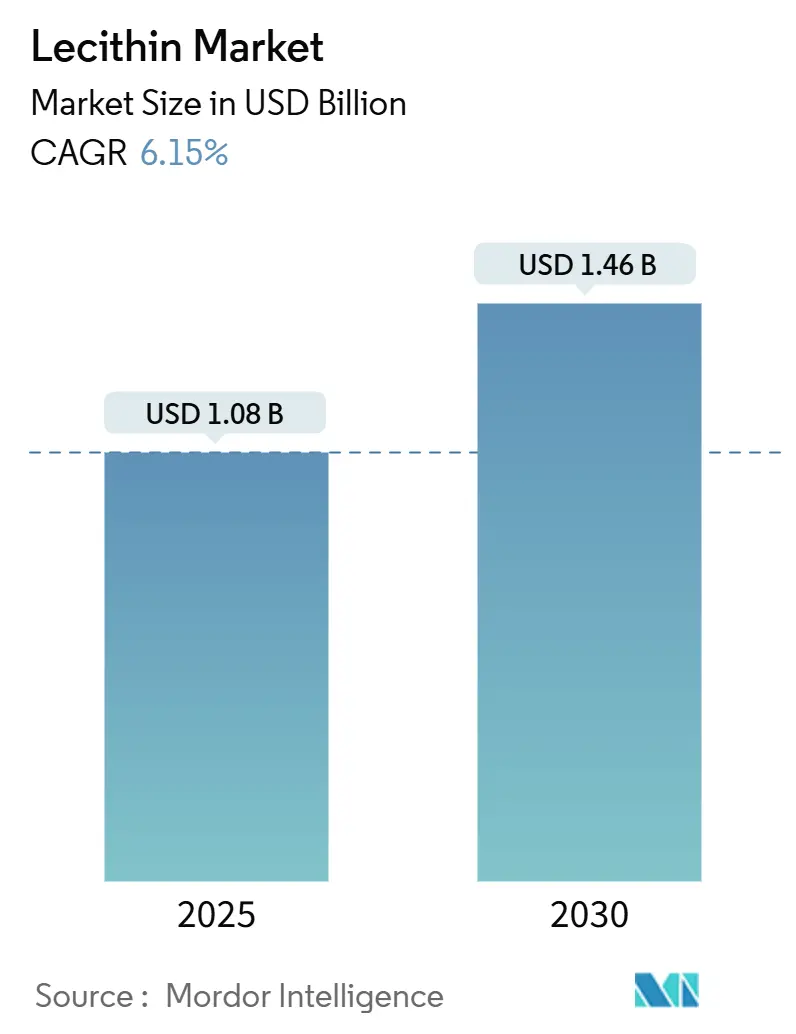
Lecithin Market Analysis by Mordor Intelligence
The lecithin market size is valued at USD 1.08 billion in 2025 and is forecast to reach USD 1.46 billion by 2030, advancing at a 6.15% CAGR during 2025-2030. Rising uptake of natural emulsifiers in processed foods, stringent clean-label regulations, and deepening penetration of pharmaceutical-grade phospholipids keep demand on a solid upward path. In parallel, pharmaceutical companies extend lecithin’s reach into drug-delivery and cognitive-health products, lifting average selling prices in the high-purity segment. Sunflower lecithin is experiencing significant growth due to its non-GMO status and allergen-free properties in clean-label formulations. Food and beverage manufacturers in North America and Europe are transitioning from soy-based to sunflower-derived lecithin as consumers become more concerned about genetically modified ingredients. The neutral flavor profile and high phospholipid content of sunflower lecithin make it suitable for plant-based dairy, bakery, and confectionery products. The pharmaceutical industry is also increasing its use of sunflower lecithin in liposomal drug delivery systems, where high purity and traceability requirements drive growth in the high-purity lecithin segment.
Key Report Takeaways
- By source, soy held 65.49% of the lecithin market share in 2024, whereas sunflower is poised for the fastest 7.89% CAGR through 2030.
- By grade, food grade commanded a 57.15% share in 2024 while pharmaceutical grade lead growth at a 9.37% CAGR during 2025-2030.
- By form, liquid accounted for 59.81% share of the lecithin market size in 2024; powder is set to accelerate at 7.24% CAGR to 2030.
- By nature, conventional products dominated with an 83.45% share in 2024, yet organic variants are forecast to expand at an 8.97% CAGR.
- By application, food and beverage captured a 51.45% share in 2024, whereas nutrition and dietary supplements are set to record the highest 9.01% CAGR through 2030.
- By geography, North America led with a 35.69% share in 2024; Asia-Pacific is the fastest-growing geography, advancing at an 8.72% CAGR during 2025-2030.
Global Lecithin Market Trends and Insights
Drivers Impact Analysis
| Driver | (~) % Impact on CAGR Forecast | Geographic Relevance | Impact Timeline |
|---|---|---|---|
| Rising need for emulsifiers and stabilizers in processed foods | +1.8% | Global, with concentration in North America and Europe | Medium term (2-4 years) |
| Increased adoption in animal feed applications | +1.2% | Global, particularly strong in Asia-Pacific and South America | Long term (≥ 4 years) |
| Expanding applications in pharmaceutical and nutraceutical industries | +1.5% | North America and Europe leading, Asia-Pacific emerging | Long term (≥ 4 years) |
| Growing demand from plant-based and vegan food sectors | +0.9% | North America and Europe core, expanding to Asia-Pacific | Medium term (2-4 years) |
| Consumer demand for clean-label and natural food ingredients | +0.7% | Global, with premium markets leading adoption | Short term (≤ 2 years) |
| Increased adoption in natural cosmetics formulations | +0.4% | Europe and North America, expanding to Asia-Pacific | Medium term (2-4 years) |
| Source: Mordor Intelligence | |||
Rising Need for Emulsifiers and Stabilizers in Processed Foods
The processed food industry is shifting toward natural emulsifiers, making lecithin an essential ingredient for maintaining product stability while meeting clean-label requirements. The increasing consumer preference for convenient, shelf-stable, and ready-to-eat food products has created a higher demand for emulsifying and stabilizing agents that maintain consistency, improve texture, and extend shelf life. Lecithin, extracted from natural sources such as soybeans, sunflower seeds, and eggs, serves multiple functions as an emulsifier, dispersing agent, and wetting agent, providing manufacturers with versatility and cost efficiency. The clean-label movement has encouraged food producers to choose natural additives like lecithin over synthetic alternatives, increasing its market demand. Consumer spending on processed and packaged foods remains strong, as evidenced by U.S. households spending an average of USD 574 on bakery products in 2023, according to the Bureau of Labor Statistics [1]Source: Bureau of Labor Statistics, "Average annual expenditures and characteristics of all consumer units," bls.gov.
Increased Adoption in Animal Feed Applications
Animal nutrition applications represent a significant growth area for lecithin demand, supported by regulatory approvals and demonstrated benefits in livestock productivity. The Food and Drug Administration (FDA)'s 21 CFR Part 573 regulations confirm lecithin's safety for animal feed applications, providing a clear regulatory framework for feed manufacturers and ensuring consistent implementation across the industry [2]Source: CFR, "Code of Federal regulations," ecfr.gov. The phospholipid content in lecithin improves fat digestion in monogastric animals, resulting in better growth rates and feed efficiency in livestock operations. The aquaculture industry has become a major driver of demand for functional feed ingredients like lecithin. The Food and Agriculture Organization of the United Nations (FAO) reports that global aquaculture production reached 130.9 million tons in 2022/23, contributing to a total fisheries and aquaculture output of 223.2 million tons, representing a 4% increase from 2020 [3]Source: Food and Agriculture Organization, "FAO Report: Global fisheries and aquaculture production reaches a new record high," fao.org. This growth has increased pressure on aquafeed and animal feed industries to incorporate sustainable, plant-based alternatives to conventional feed ingredients.
Expanding Applications in Pharmaceutical and Nutraceutical Industries
The expanding applications of lecithin in the pharmaceutical and nutraceutical industries are emerging as a significant growth catalyst for the global lecithin market. Lecithin's functional versatility, rooted in its rich phospholipid profile, makes it an essential ingredient in advanced drug delivery systems. In pharmaceutical formulations, lecithin is widely utilized for its emulsifying, solubilizing, and bioavailability-enhancing properties. Specialized lecithin derivatives, including phosphatidylserine and phosphatidylcholine, command higher market prices than standard lecithin, creating opportunities for specialized manufacturers. The Food and Drug Administration (FDA)'s Generally Recognized as Safe (GRAS) designation for lecithin in pharmaceutical applications reinforces its position in therapeutic products. The nutraceutical industry increasingly incorporates lecithin compounds in functional foods and dietary supplements, particularly those targeting cognitive health, liver function, and metabolism.
Growing Demand from Plant-Based and Vegan Food Sectors
Plant-based food formulations require sophisticated emulsification systems to match the texture and stability characteristics of animal-derived products, making lecithin a crucial ingredient in product development. Bunge's specialized lecithin portfolio addresses technical requirements in plant-based foods, including effective release properties, non-stick characteristics, and emulsion stabilization in dairy alternatives and meat substitutes. Sunflower lecithin offers significant advantages in plant-based applications due to its allergen-free status, enabling manufacturers to develop products for consumers with specific dietary restrictions. The technical challenge of achieving dairy-like textures in plant-based alternatives drives developments in lecithin modification techniques, creating opportunities for suppliers offering specialized functionality solutions. As consumer acceptance of plant-based products increasingly depends on matching the sensory qualities of conventional foods, lecithin's emulsification capabilities remain essential for market success.
Restraints Impact Analysis
| Restraint | (~)% Impact on CAGR Forecast | Geographic Relevance | Impact Timeline |
|---|---|---|---|
| Fluctuating Raw Material Prices | -1.4% | Global, with particular impact on cost-sensitive applications | Short term (≤ 2 years) |
| Negative consumer perception of GMO ingredients | -0.8% | Europe and North America primarily, expanding to Asia-Pacific | Medium term (2-4 years) |
| Competition from alternative emulsifiers and surfactants | -0.6% | Global, with synthetic alternatives in price-sensitive segments | Long term (≥ 4 years) |
| Limited shelf life of liquid lecithin products | -0.3% | Global, affecting distribution and inventory management | Medium term (2-4 years) |
| Source: Mordor Intelligence | |||
Fluctuating Raw Material Prices
The lecithin market faces significant constraints due to fluctuating raw material prices, particularly soybeans, sunflower seeds, and eggs. These primary sources are vulnerable to various factors, including weather conditions, geopolitical issues, trade policies, and supply chain disruptions. For instance, extreme weather events or droughts in major producing regions such as the United States, Brazil, or Ukraine can reduce crop yields, affecting the availability and cost of lecithin production materials. The volatility in the broader edible oil market also influences lecithin prices, as lecithin is derived from oilseed processing. Changes in soybean or sunflower oil demand, whether from shifting consumption patterns or biofuel regulations, affect lecithin supply and pricing. This instability creates challenges for manufacturers in maintaining stable cost structures and profit margins. The increased production costs also affect lecithin's competitiveness against synthetic emulsifiers, particularly in price-sensitive markets.
Negative Consumer Perception of GMO Ingredients
Consumer resistance to genetically modified ingredients drives demand for non-GMO lecithin alternatives, creating supply constraints and premium pricing for certified non-GMO products. Sternchemie's GRAS recognition for sunflower lecithin addresses this concern by providing a naturally non-GMO alternative suitable for clean-label applications. The European market particularly emphasizes non-GMO sourcing, with regulatory frameworks increasingly favoring natural additives over synthetic alternatives [4]Source: CBI Ministry of Foreign Affairs, "Which trends offer opportunities or pose a threat on the European natural food additives market?, "cbi.eu. Sunflower lecithin commands premium pricing due to its inherently non-GMO status and allergen-free profile, but supply limitations constrain market growth potential. The shift toward non-GMO alternatives requires significant supply chain restructuring, as traditional soy lecithin producers must secure certified non-GMO soybeans or diversify into alternative sources. Consumer education efforts by ingredient suppliers focus on lecithin's natural origin and functional benefits, but perception challenges persist in price-sensitive market segments where GMO concerns compete with cost considerations.
Segment Analysis
By Source: Soy Dominance Faces Sunflower Challenge
Soy lecithin holds a dominant 65.49% market share in 2024, supported by established supply chains and cost benefits from the global soybean processing infrastructure. Sunflower lecithin represents the fastest-growing source segment with a projected 7.89% CAGR during 2025-2030, driven by its non-GMO status and allergen-free characteristics that align with consumer health preferences and increasing market demands. Egg lecithin maintains its position in specialized applications requiring superior functionality, particularly in pharmaceutical and premium food products, while demonstrating consistent performance in high-value segments.
Rapeseed lecithin has emerged as a viable alternative during supply chain disruptions affecting conventional sources, offering manufacturers additional sourcing flexibility. Alternative sources, including canola lecithin, have expanded their market presence through regulatory approvals, such as Cargill's Food and Drug Administration (FDA) Generally Recognised as Safe (GRAS) determination, enabling broader use in organic and non-GMO formulations.
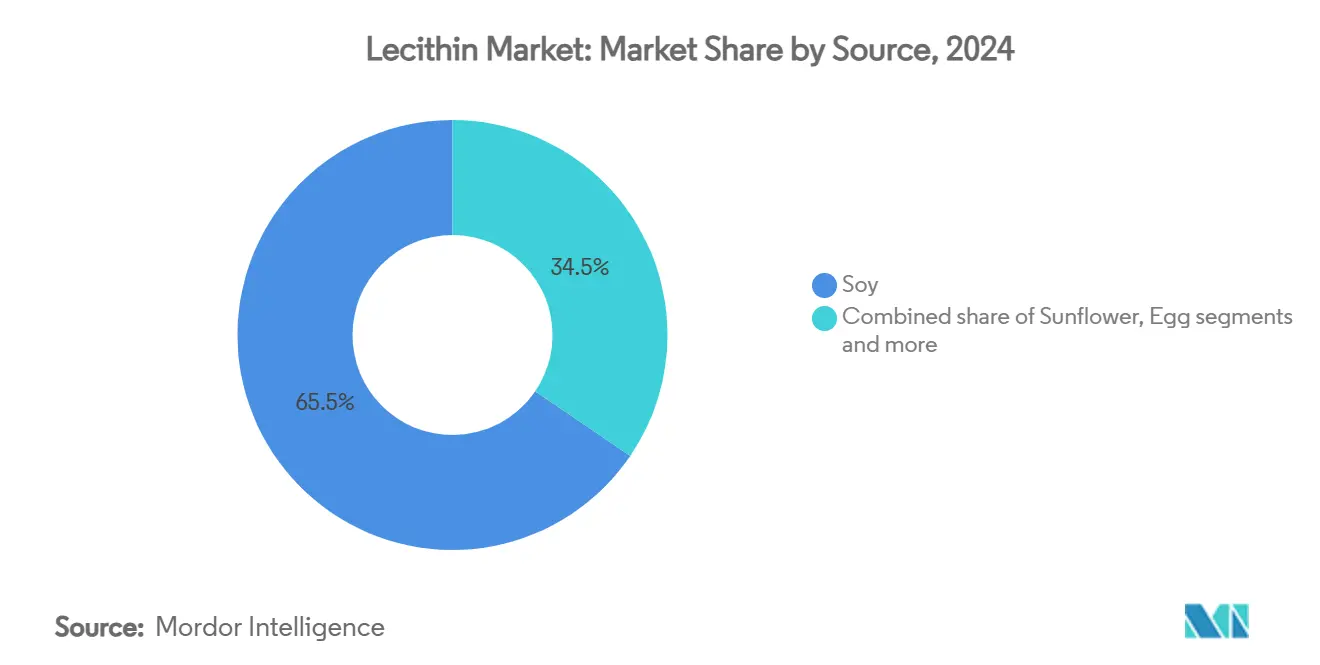
Note: Segment shares of all individual segments available upon report purchase
By Grade: Pharmaceutical Applications Drive Premium Growth
Food grade lecithin holds 57.15% market share in 2024, primarily serving the processed food industry with emulsification solutions across bakery, confectionery, and dairy applications. The ingredient demonstrates significant versatility in food processing operations. Pharmaceutical grade lecithin projects a 9.37% CAGR during 2025-2030, driven by its increasing use in drug delivery systems and nutraceutical formulations. The pharmaceutical segment expands through lecithin's proven safety profile and Food and Drug Administration (FDA) approval for various applications. The regulatory acceptance strengthens market growth potential across pharmaceutical formulations.
Additional grades, including cosmetic and industrial applications, present growth opportunities as manufacturers implement lecithin in non-traditional uses. Companies such as American Lecithin Company advance the pharmaceutical-grade segment by developing specialized derivatives, including phosphatidylserine from soy and sunflower lecithins. These formulations comply with stringent pharmaceutical quality standards and specifications. The high-value derivatives enable suppliers to benefit from premium pricing and enhanced profit margins in pharmaceutical applications.
By Form: Powder Gains Ground on Handling Advantages
Liquid lecithin dominates the market with a 59.81% share in 2024, due to its efficient incorporation in large-scale food processing and superior emulsification properties in applications requiring quick dispersion. Powder lecithin is projected to grow at a 7.24% CAGR during 2025-2030, supported by its practical handling features, longer shelf life, and lower transportation costs, which benefit manufacturers' operational efficiency. Other forms, including granulated and modified variants, cater to specific applications that require particular particle sizes or enhanced functionality. End-use requirements primarily determine form selection, with liquid formats chosen for immediate processing needs and powder forms selected for better inventory management and distribution.
Advancements in spray-drying and encapsulation methods enhance powder lecithin's functionality, enabling it to compete with liquid forms in traditional liquid-dominated applications. The powder segment's growth aligns with clean-label preferences, as manufacturers prioritize minimally processed ingredients with better stability. The advantages in distribution become crucial amid global supply chain challenges, with powder lecithin's reduced shipping and storage costs attracting international customers.
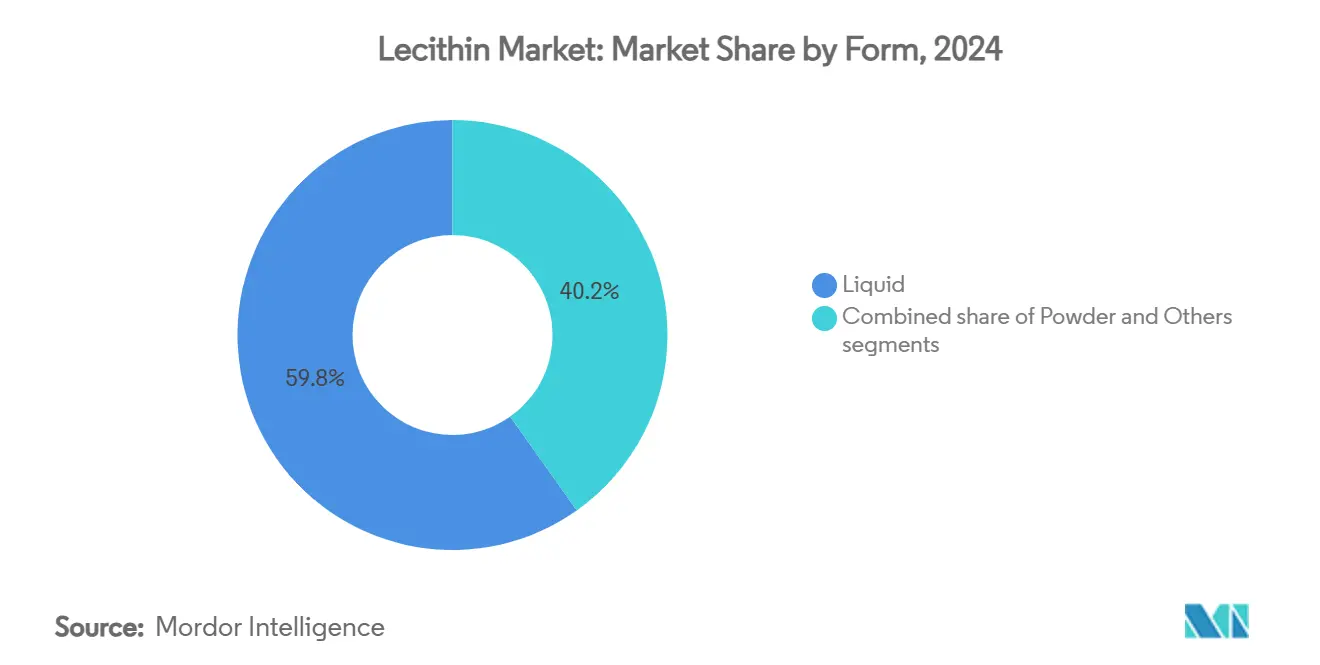
Note: Segment shares of all individual segments available upon report purchase
By Nature: Organic Segment Captures Premium Positioning
Conventional lecithin holds a dominant 83.45% market share in 2024, supported by established supply chains and cost advantages that enable widespread use across various applications and price segments. The organic lecithin segment projects a CAGR of 8.97% during 2025-2030, supported by consumers' acceptance of premium pricing for certified organic ingredients and favorable regulations for organic food production. However, the organic segment experiences supply limitations due to restricted certified organic oilseed production, creating market opportunities for suppliers with reliable organic sourcing capabilities.
The higher pricing in organic applications generates sufficient margins to offset organic certification and supply chain management costs. The organic segment gains support from regulatory developments, including European Food Safety Authority (EFSA)'s revised guidelines for novel foods that prioritize natural ingredients and sustainable production practices. Organic food manufacturers' consumer awareness programs emphasize lecithin's natural properties and functional advantages, enhancing market acceptance. The combination of organic and non-GMO preferences generates significant demand for organic sunflower lecithin, though supply constraints limit market expansion.
By Application: Nutrition Supplements Outpace Traditional Food Uses
Food and beverage applications hold a 51.45% market share in 2024, primarily driven by bakery and confectionery segments. Lecithin's ability to enhance texture and extend shelf life has established its importance across various product categories. The nutrition and dietary supplements segment is projected to grow at a 9.01% CAGR during 2025-2030, supported by increased consumer awareness of lecithin's health benefits in cognitive and cardiovascular wellness products.
Animal feed applications continue to expand due to regulatory approvals and demonstrated improvements in feed conversion ratios. The pharmaceutical sector maintains premium pricing through specialized lecithin formulations. The cosmetics and personal care industry presents growth potential as manufacturers incorporate lecithin's emulsification properties in natural beauty products. The broad distribution across multiple applications reduces market concentration risks and allows suppliers to optimize their product portfolios for enhanced profitability across end-use segments.
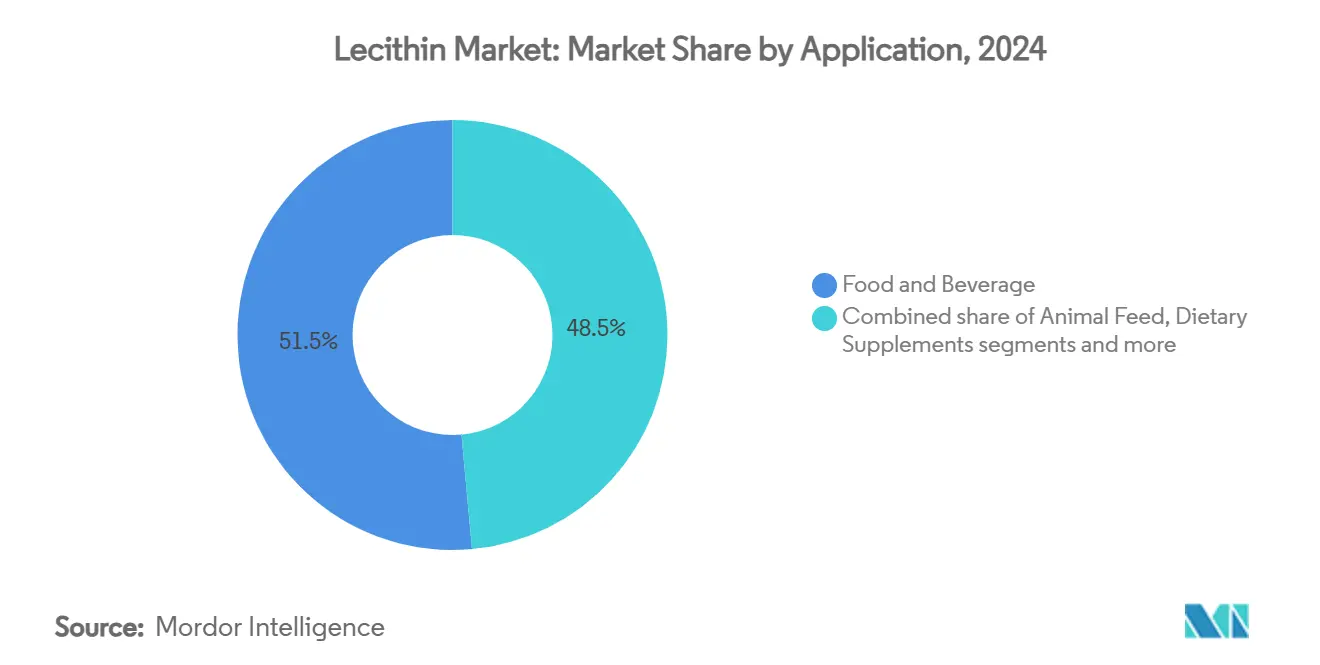
Note: Segment shares of all individual segments available upon report purchase
Geography Analysis
North America holds a dominant 35.69% share of the lecithin market in 2024, supported by strict Food and Drug Administration (FDA) regulations favoring natural emulsifiers. The region maintains balanced capacity through significant investments in soybean and canola crushing facilities and increased plant-based food product launches. High consumer spending on supplements drives the adoption of premium phospholipids in brain-health products. Asia-Pacific demonstrates the highest growth rate with an 8.72% CAGR during 2025-2030. The expansion of China's supplement industry and India's bakery chains drives demand for both standard and premium lecithin products.
Asia-Pacific emerges as the fastest-growing region with a CAGR of 8.72% during 2025-2030, driven by expanding nutraceutical markets and rising disposable incomes that enable premium ingredient adoption. China's dietary supplement market, particularly for lecithin applications in cognitive health and cardiovascular wellness products, contributes significantly to regional demand expansion. The region's processed food manufacturing base generates substantial demand for cost-effective emulsification solutions, while increasing consumer awareness of health benefits supports premium lecithin usage in various applications.
Europe maintains a balanced approach between volume and value segments. European Food Safety Authority (EFSA) regulations and GMO concerns drive demand toward sunflower and rapeseed lecithin. Eastern European producers benefit from proximity to sunflower production regions, pending resolution of geopolitical issues. South America serves as a key supply center, leveraging Brazil's substantial soybean production. The Middle East and Africa present growth potential due to the expansion of food processing industries and rising consumer awareness of functional ingredients. However, infrastructure constraints and underdeveloped regulatory frameworks continue to limit market growth compared to mature markets.
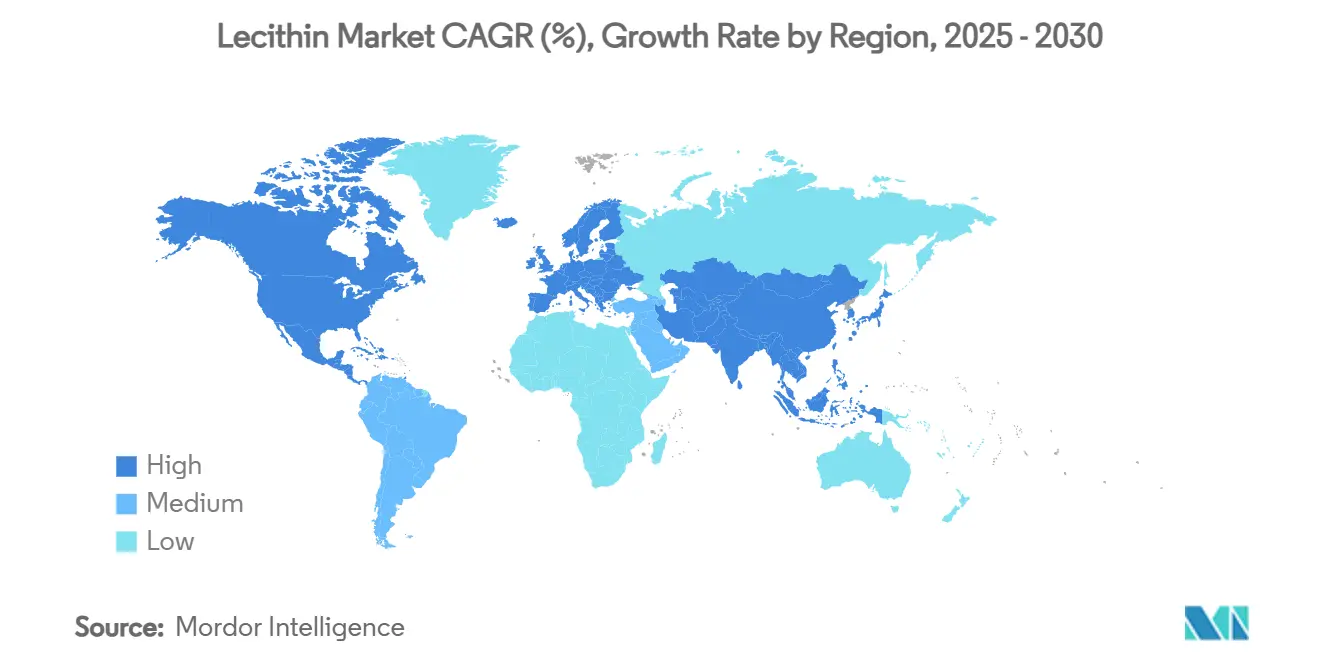
Competitive Landscape
Major players, including Archer Daniels Midland, Cargill Inc., Lipoid GmbH, International Flavors & Fragrances (a DuPont subsidiary), and Wilmar International, dominate the moderately concentrated lecithin market. Leveraging vertical integration, these firms navigate supply chain fluctuations and guarantee product traceability, channeling resultant cost savings into research and development. This strategic approach enables them to maintain a competitive edge in product innovation and market positioning.
Technological competition centers on fractionation processes, elevating phosphatidylcholine content to over 90% a key requirement for intravenous lipid emulsions. Firms are pioneering sustainable extraction techniques, notably membrane filtration, which curtails hexane usage by 25%. These advancements align with the growing demand for environmentally friendly production methods in the market.
In Europe's allergen-sensitive confectionery sector, smaller entities like Sternchemie carve a niche with their non-GMO sunflower and rapeseed lecithin. To bolster their foothold in the nutraceutical arena, these firms forge strategic partnerships with contract packagers and capsule producers. Such collaborations allow them to expand their product offerings and cater to a broader consumer base.
Lecithin Industry Leaders
-
Lipoid GmbH
-
Wilmar International
-
Cargill Inc.
-
Archer Daniels Midland Company
-
International Flavors & Fragrances, Inc.
- *Disclaimer: Major Players sorted in no particular order
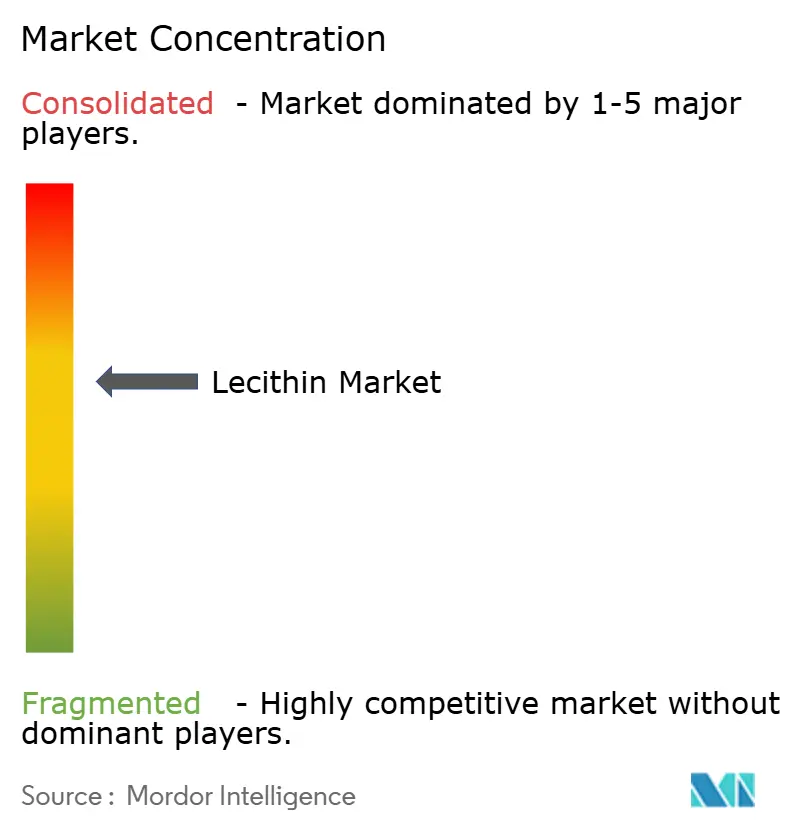
Recent Industry Developments
- June 2025: Austrade Inc. introduced a non-GMO hydrolyzed sunflower lecithin powder to expand its clean-label ingredient portfolio, addressing the increasing demand from functional beverage manufacturers. The ingredient, produced through enzymatic hydrolysis and concentration, achieves a hydrophilic-lipophilic balance (HLB) of 9-10, enabling stable oil-in-water emulsions.
- May 2025: Louis Dreyfus Company (LDC) established a new automated specialty feed lecithin production line at its oilseed crushing facility in Tianjin, China. The facility operates on renewable electricity and was developed with the company's Shanghai research and development center.
- December 2024: Louis Dreyfus Company signed a binding agreement to acquire BASF’s Food and Health Performance Ingredients business, adding advanced lecithin lines to its specialty portfolio.
- August 2024: Bunge expanded its lecithin portfolio in North America by introducing deoiled soybean lecithin in powdered and granulated formats. This addition complements its existing offerings of crude, standard, and specialty lecithins from soybean, sunflower, and rapeseed.
Global Lecithin Market Report Scope
Lecithin is a fatty substance necessary for the body's cells. Lecithin can be found in many food products, including soybeans and egg yolks. It is taken as a medicine and is also utilized in the manufacturing of drugs.
The global lecithin market is segmented by source, application, and geography. Based on the source, the market is segmented into egg, soy, sunflower, and others. Based on application, the market is segmented into food and beverage, feed, nutrition and supplements, pharmaceuticals, and other applications. The study also covers the global analysis of the major regions, such as North America, Europe, Asia-Pacific, South America, the Middle East, and Africa.
For each segment, the market sizing and forecasts have been done based on value (in USD million).
| Soy |
| Sunflower |
| Egg |
| Rapeseed |
| Other Sources |
| Food Grade |
| Pharmaceutical Grade |
| Others |
| Liquid |
| Powder |
| Others |
| Organic |
| Conventional |
| Food and Beverage | Bakery and Confectionery |
| Dairy Products | |
| Beverages | |
| Other Food and Beverages | |
| Animal Feed | |
| Dietary Supplements | |
| Pharmaceuticals | |
| Cosmetics and Personal Care | |
| Other Application |
| North America | United States |
| Canada | |
| Mexico | |
| Rest of North America | |
| Europe | Germany |
| France | |
| United Kingdom | |
| Spain | |
| Netherlands | |
| Italy | |
| Sweden | |
| Poland | |
| Belgium | |
| Rest of Europe | |
| Asia-Pacific | China |
| India | |
| Japan | |
| Australia | |
| South Korea | |
| Indonesia | |
| Thailand | |
| Singapore | |
| Rest of Asia-Pacific | |
| South America | Brazil |
| Argentina | |
| Chile | |
| Colombia | |
| Peru | |
| Rest of South America | |
| Middle East and Africa | United Arab Emirates |
| South Africa | |
| Nigeria | |
| Saudi Arabia | |
| Egypt | |
| Morocco | |
| Turkey | |
| Rest of Middle East and Africa |
| By Source | Soy | |
| Sunflower | ||
| Egg | ||
| Rapeseed | ||
| Other Sources | ||
| By Grade | Food Grade | |
| Pharmaceutical Grade | ||
| Others | ||
| By Form | Liquid | |
| Powder | ||
| Others | ||
| By Nature | Organic | |
| Conventional | ||
| By Application | Food and Beverage | Bakery and Confectionery |
| Dairy Products | ||
| Beverages | ||
| Other Food and Beverages | ||
| Animal Feed | ||
| Dietary Supplements | ||
| Pharmaceuticals | ||
| Cosmetics and Personal Care | ||
| Other Application | ||
| By Geography | North America | United States |
| Canada | ||
| Mexico | ||
| Rest of North America | ||
| Europe | Germany | |
| France | ||
| United Kingdom | ||
| Spain | ||
| Netherlands | ||
| Italy | ||
| Sweden | ||
| Poland | ||
| Belgium | ||
| Rest of Europe | ||
| Asia-Pacific | China | |
| India | ||
| Japan | ||
| Australia | ||
| South Korea | ||
| Indonesia | ||
| Thailand | ||
| Singapore | ||
| Rest of Asia-Pacific | ||
| South America | Brazil | |
| Argentina | ||
| Chile | ||
| Colombia | ||
| Peru | ||
| Rest of South America | ||
| Middle East and Africa | United Arab Emirates | |
| South Africa | ||
| Nigeria | ||
| Saudi Arabia | ||
| Egypt | ||
| Morocco | ||
| Turkey | ||
| Rest of Middle East and Africa | ||
Key Questions Answered in the Report
What is the value of the global lecithin market in 2025 and how large will it be by 2030?
The Lecithin Market size is expected to reach USD 1.08 billion in 2025 and grow at a CAGR of 6.15% to reach USD 1.46 billion by 2030.
Which source category controls the largest share and which one is growing the fastest?
Soy lecithin leads with 65.49% share in 2024, while sunflower lecithin is set to expand at the quickest 7.89% CAGR through 2030.
Which region is expected to record the highest growth rate during 2025-2030?
Asia-Pacific is projected to advance at an 8.72% CAGR, outpacing all other regions thanks to rising nutraceutical demand and increasing disposable incomes
What are the primary growth drivers that executives should monitor?
Regulatory pressure for clean-label formulations, expanding pharmaceutical and nutraceutical uses, and heightened demand from plant-based food makers are the key forces lifting the market
Page last updated on:



